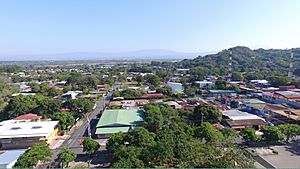Colón, Costa Rica facts for kids
Quick facts for kids
Colón
|
|
|---|---|
|
District
|
|

Ciudad Colón, aerial view
|
|
| Country | |
| Province | San José |
| Canton | Mora |
| Area | |
| • Total | 40.12 km2 (15.49 sq mi) |
| Elevation | 840 m (2,760 ft) |
| Population
(2011)
|
|
| • Total | 16,088 |
| • Density | 401.00/km2 (1,038.58/sq mi) |
| Time zone | UTC−06:00 |
| Postal code |
10701
|
Colón, also known as Ciudad Colón, is a lively town in Costa Rica. It's the main city of the Mora area, located in the San José province. People love Colón for its warm weather, beautiful mountains, and rich traditions. It's also a great place for horse riding and experiencing different cultures.
Contents
What's in a Name?
Colón is named after the famous explorer Christopher Columbus. In Spanish, his name is Cristobal Colón. Before it was called Ciudad Colón, it was known as Villa Colón. Even earlier, it was called Pacaca, named after a local tribal chief.
Where is Colón?
Colón covers an area of about 40 square kilometers. It sits at an elevation of 840 meters above sea level. This means it's quite high up in the mountains!
Who Lives in Colón?
| Historical population | |||
|---|---|---|---|
| Census | Pop. | %± | |
| 1864 | 898 | — | |
| 1883 | 879 | −2.1% | |
| 1892 | 891 | 1.4% | |
| 1927 | 2,715 | 204.7% | |
| 1950 | 2,699 | −0.6% | |
| 1963 | 3,542 | 31.2% | |
| 1973 | 5,122 | 44.6% | |
| 1984 | 7,361 | 43.7% | |
| 2000 | 13,477 | 83.1% | |
| 2011 | 16,088 | 19.4% | |
|
Instituto Nacional de Estadística y Censos |
|||
In 2011, about 16,088 people lived in Colón. It's a small town with a friendly feel.
Colón has many shops, banks, and pharmacies. You can find everything you need for daily life. It's a great place for outdoor fun like horse riding and biking. You can also enjoy running and hiking in the beautiful nature.
Special Places in Colón
United Nations University for Peace
About 6 kilometers from town is the United Nations University for Peace (UPEACE). This university brings people from all over the world to Colón. Students and teachers from more than 60 countries live here. This makes Colón one of the most multicultural towns of its size.
Quitirrisí Indigenous Reserve
Close to Colón is Quitirrisí. This is a special area for an indigenous tribe. They are well-known for their amazing handmade crafts.
Getting Around Colón
Road Routes
Several important roads connect Colón to other places. These roads help people travel in and out of the district.
Images for kids
See also
 In Spanish: Colón (Costa Rica) para niños
In Spanish: Colón (Costa Rica) para niños



